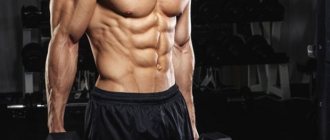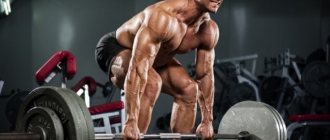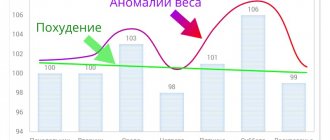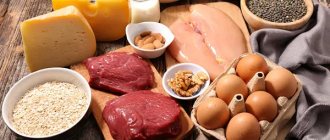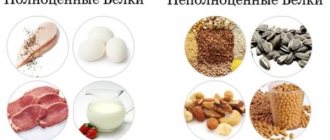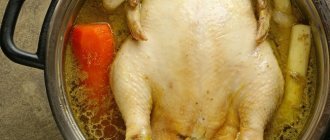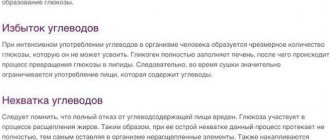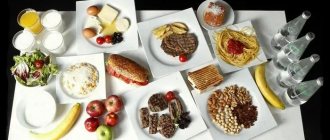Drying the body is a process during which a person strives to reduce the percentage of fatty tissue in the body as much as possible, while maintaining muscle mass and strength. Simply put, drying is a set of measures that consists of a special low-calorie diet and intense training. The main task of athletes during this period is to maximize physical activity, actively consume protein foods and reduce carbohydrates in the diet. This process is quite complex, requiring a serious approach, as it has a number of contraindications and side effects.
Who needs body drying and how it differs from losing weight
The method of drying the body in order to reduce the amount of subcutaneous fat is most often used by professional athletes. After all, it is impossible to be at the same weight and physical shape all year round. Therefore, bodybuilders first gain weight, and after a while they begin to “dry out.” The process of gaining weight allows you to build muscle, and drying gets rid of the fat layer, forming a beautiful relief.
However, drying the body is relevant not only for professional athletes. It is also useful for people who have problems with excess weight. Since only an integrated approach will help you get rid of extra pounds. A well-structured nutrition system and an appropriate training program.
Please note that professional body drying differs from regular weight loss with a change in diet and regular physical activity. People who just want to lose weight are working for long-term results. Proper weight loss requires a long period of dieting and systematic exercise. Often, those who are predisposed to obesity have to adhere to certain dietary rules throughout their lives. This is how they manage to stay in shape.
When drying, a special menu is drawn up. All fat-containing foods are excluded from the daily diet, the amount of carbohydrates is reduced to a minimum (or also eliminated), and salt is removed. Sticking to such a diet for a long time is not recommended. Otherwise, instead of the expected benefit, you can only harm the body. Lost weight will be returned in double volume, which is explained by the slowdown of metabolic processes during fasting.
Therefore, unlike the usual getting rid of extra pounds, which should take place smoothly and systematically, without any special prohibitions on a variety of foods, drying the body should be short-lived.
How to get in and out of drying
The main component of drying is a change in diet, which involves a smooth entry and exit. You can’t start drying suddenly. The body must be gradually prepared for extreme stress.
- First of all, gradually cut back on the amount of carbohydrates you consume. This should be done in advance, several weeks before drying. Remove sweets from your diet, then gradually reduce the amount of fruits, pasta, and cereals with a high glycemic index. Minimize your intake of fats and complex carbohydrates.
- During the drying process, try to eat small portions, but often. Preferably every 2-3 hours. Don't forget about enough liquid. This is approximately 2-2.5 liters per day.
- Skip the salt. But if you are not a professional athlete who is preparing for serious competitions, it is enough to add less of it to your dishes. Drying for athletes takes place under much more stringent conditions compared to those who simply want to lose weight.
- Be sure to eat after training so that your body can recover from intense exercise.
When your efforts have brought the long-awaited result, do not rush to immediately increase the caloric content of your diet. The exit from drying should be just as smooth. After all, while you are drying out, metabolic processes in the body slow down greatly. A rapid transition to a regular menu will inevitably lead to excess weight gain, and all efforts will be in vain.
To prevent this from happening, proceed very carefully. Gradually add foods to your diet and carefully monitor your body's response to changes. Keep in mind, consuming carbohydrates after cutting will cause puffiness. Enter them into the menu smoothly. Start with small amounts of fruit and dairy products, gradually returning to your normal diet.
Review of the best diets for cutting
There are many ways to remove excess subcutaneous fat. We have selected 4 of the most effective options for you and described their basic principles and advantages.
No carbohydrate diet
The most popular among athletes is the low-carbohydrate diet. Formally, it is rather low-carbohydrate, since in practice it is impossible to limit the small amount of carbohydrates ingested from food. When choosing a diet for cutting, many athletes choose the classic “no-carbohydrate” diet due to its effectiveness. The essence of the diet is clear from the name - limit the intake of any carbohydrates into the body.
Authorized Products
On a low-carbohydrate diet, you are allowed to consume:
- lean meat: chicken, turkey, beef, lean pork, rabbit, lamb;
- fish, seafood;
- eggs;
- green vegetables high in fiber;
- dairy products: hard cheeses, milk, cottage cheese, kefir, fermented baked milk, sour cream;
- drinking water (at least 2-3 liters per day).
Operating principle
The principle is based on the mechanism of gluconeogenesis - the formation of glucose from other compounds in the body in order to maintain metabolism. Without the intake of carbohydrates, the body begins to break down fats into fatty acid molecules and glycerol, and proteins into amino acids, from which it creates glucose. This process is very energy-consuming, and in the complete absence of carbohydrate foods it leads to rapid weight loss. But when adhering to such a diet, be careful, since an acute lack of glucose in the body causes the phenomenon of ketosis.
Ketosis is the body's breakdown of previously accumulated fat to produce energy (glucose). With ketosis, the liver begins to actively produce ketonic acid, which increases the risk of poisoning with acetone products.
If the accumulation of ketone bodies reaches maximum values, ketoacidosis may begin in the body - acute poisoning with decay products. A sharp acetone odor appears from the mouth, the general condition worsens, severe dizziness, nausea or vomiting occurs. With serious complications and lack of treatment, ketoacidosis can be fatal (especially if a person has diabetes mellitus or another metabolic disorder).
And yet, “no carbohydrates” is the undisputed leader when choosing a diet for drying the body for many athletes, as it allows you to achieve excellent results in losing weight in a short time.
An analogue is the Dr. Atkins diet, which traditionally takes place in four stages: the induction stage (preparatory), the active fat burning stage, the transition stage and the maintenance stage. The Dr. Atkins diet is a classic low-carb diet.
Zone diet
The zone diet is often chosen by those athletes who train intensively even while cutting. Thanks to the balanced composition of the diet (there is no strict restriction of carbohydrates), it allows you to train as intensely as possible without experiencing an acute energy deficiency (an integral part of low-carbohydrate diets).
Operating principle
The essence of the zone diet is to divide the daily diet into proteins, fats and carbohydrates in the ratio: 30/30/40, respectively. The zone diet requires an individual approach, since to create a menu it is necessary to calculate the individual protein requirement of a particular athlete.
Principles of the zone diet:
- The entire daily diet is divided into protein, carbohydrate and fat blocks. At the same time, one protein block contains 7 grams of protein, one carbohydrate block contains 9 grams of carbohydrates, and one fat block contains 1.5 grams of fat.
- The ratio of protein and carbohydrate blocks should be 1:1.
- The number of meals per day is at least 5: 3 main meals and 2 snacks. If you're training too intensely while cutting, you should increase the number of meals you eat, not the size of your portions.
- The calorie content of a main meal should not exceed 500 calories, and a snack should not exceed 150 calories.
- Between meals, breaks of more than 4 hours are not allowed.
- It is better to choose low fat protein sources.
- Fats in the diet should be unsaturated.
- Carbohydrates should have a low glycemic index.
Recommended Products
The zone diet does not impose strict restrictions on the foods consumed. Only their calorie content and set of nutrients are controlled.
Drying in such conditions may not be as effective, but in combination with intense physical activity, the results of the zone diet will not take long to appear.
Paleo diet
The Paleo diet is considered the most preferred among CrossFitters, as its creator is the founder of CrossFit, Greg Glassman. This diet is based on eating only high-quality protein sources: meat, fish, seafood, fiber-rich fruits and vegetables, as well as berries and nuts. In other words, only those foods that could have been available to ancient man in the Paleolithic era are consumed.
Principles of nutrition
Paleo Diet Principles:
- It is allowed to consume only natural products that have not undergone heat or other processing or have been subjected to only minimal exposure to temperatures.
- Dairy products, grains, and all sugars are prohibited.
- It is not recommended to subject vegetables to prolonged heat treatment to avoid loss of vitamins.
- When following the paleo diet, strictly follow the drinking regime: drink at least 2-3 liters of liquid per day.
- During intense physical activity, it is permissible to increase the amount of carbohydrates in food by consuming sweet berries and fruits. The amount of protein in this situation is also allowed to be increased.
Priority Products
The paleo diet is certainly a healthy way of eating, since by consuming a large amount of vegetables, fruits, berries and nuts, the body receives many vitamins, macro and microelements, and the overall immune system is strengthened. In terms of cutting, such a diet is also effective, since giving up simple carbohydrates and replacing them with fiber in any case leads to intense burning of fat.
Fractional meals
Fractional meals are another popular diet for drying the body. The essence of fractional nutrition is to divide the daily diet into 6-7 small meals at intervals of 2-2.5 hours. The fractional diet is aimed at reducing single portions of food in order to improve the functioning of the gastrointestinal tract, compress the volume of the stomach in a natural way, improve metabolism and burn accumulated fat deposits.
Principles of nutrition
A fractional diet involves following a number of recommendations:
- Alternate days of nutrition with days of rest: 5 days - fractional meals, 10 days - consolidation of the result.
- During the first 5 days of fractional feeding, eat every 2 hours.
- During the 10 days of rest, eat the same foods, just reduce the number of meals while maintaining its total volume.
- The recommended serving size is such that after eating there is a slight feeling of hunger.
- Don't forget about drinking water. At least 2.5-3 liters of clean drinking water per day is the key to successful drying.
Recommended Products
The following products are of priority:
- The diet for a fractional diet consists mainly of low-fat protein foods: chicken, turkey, rabbit, beef, fish, eggs.
- Dairy products allowed during the fractional diet include: hard cheeses with low fat content (no more than 35%), cottage cheese, kefir, fermented baked milk, and Varenets.
- Most of the diet consists of foods rich in fiber. These include: cucumbers, all types of cabbage, greens, tomatoes, bell peppers, beans, peas, bran.
- Carbohydrates in fractional meals are complex, with a low glycemic index: oatmeal, buckwheat, barley, barley.
- Fats are mainly of vegetable origin: olive oil, flaxseed oil, natural peanut oil.
This type of nutrition is rightfully considered effective in order to effectively burn excess fat. In combination with physical activity, a fractional diet gives tangible results. It is perfect for athletes who plan to quickly and comfortably get rid of extra pounds.
How to eat while drying
Looking at the many restrictions in food that the drying method implies, it is easy to understand that this process is really very difficult for our body. But if you decide to achieve the desired results using this method, you will have to be patient.
It is a special diet that allows you to quickly burn subcutaneous fat deposits. Moreover, for each person the menu is selected individually, taking into account his physiological characteristics, including the speed of metabolic processes. Someone has the opportunity to eat more carbohydrates, while others have to be content with only proteins. Therefore, to create a proper nutrition plan, you may need the help of a qualified nutritionist.
If the drying diet allows for the presence of complex, long-digestible carbohydrates, it is allowed to consume:
- brown unpolished rice;
- vegetables that contain water and fiber, but without sugar (cabbage, cucumbers, bell peppers, lettuce, greens).
When you really want something sweet, you can enjoy a carbohydrate-free sugar substitute with stevia by adding it to your tea or coffee.
A no-carbohydrate diet when cutting involves a complete abstinence from carbohydrates. Only low-fat protein foods are allowed to be eaten:
- chicken fillet (without skin);
- lean beef, veal;
- rabbit meat;
- turkey fillet and quail meat;
- chicken egg white;
- quail eggs (whole);
- various seafood and lean sea fish;
- Drinks: water, black and green tea, coffee.
Whatever the diet: low-carb or no-carb, we must not forget about enough water. When drying, which involves physical activity, its amount should not be less than 2.5 liters per day. Please note that we are talking about clean drinking water. Tea and coffee are not taken into account.
Basic rules of nutrition during drying
Eating while drying involves following strict rules. The main one is reducing the amount of carbohydrates consumed. Their content in the diet should be no more than 10-20% for men and 20-30% for girls. 40-60% of the total diet for drying should be proteins, 20-30% fats.
Since a protein diet involves a drastic change in diet and entails stress, many people wonder: how to go dry? Nutritionists recommend a gradual introduction to a protein diet. Considering the duration of the diet is 1.5 months, the preparatory period should last 1-2 weeks. At this time, the carbohydrate content in the diet should be about 30%. From 2-3 weeks you can start eating according to all the rules of the diet. There are several other important conditions:
- You need to eat fractionally, 4-6 times a day in small portions.
- Daily caloric intake should be 10-30% lower than usual.
- It is recommended to consume all carbohydrates in the first half of the day.
- It is necessary to drink at least 1.5-2 liters of clean water per day. It is advisable to avoid drinks containing caffeine, such as coffee and black tea, and replace them with herbal infusions and teas. Drinking green tea is allowed.
Sports supplements
We figured out what to eat during drying. It remains to be seen whether it is necessary to include in the diet special sports supplements that support the body in conditions of limited nutrition. It is not necessary to use them, but depending on the specifics of your diet and training program, they can slightly speed up and even make the drying process easier.
Protein
A popular supplement that contains protein and amino acids. The only type of protein that can be used in the drying process is sugar-free whey isolate. In fact, it acts as a substitute for protein products. This is a kind of way to add variety to your diet.
Creatine
Relevant for men during the period of muscle building. Helps increase muscle strength and size. But it is not suitable for drying the body. Since it does not allow you to achieve the desired relief, but only “inflates” the volumes due to fluid (the effect of creatine is based on the accumulation of water in the muscle fibers).
BCCA
This sports supplement is very useful in the cutting process. It contains amino acids that our body is not able to produce on its own (valine, isoleucine, leucine). They are the ones who prevent the destruction of muscle tissue during acute carbohydrate deficiency during drying.
L-carnitine
Acts as a light fat burner. Promotes an increase in body temperature, produces energy as a result of the breakdown of fat deposits. L-carnitine is recommended to be taken 30 minutes before training, as well as on rest days.
Fat burners
Most often, athletes use fat-burning supplements with the ECA complex (ephedrine, caffeine, aspirin). These components effectively break down fatty tissue and reduce appetite. However, fat burners are contraindicated for people prone to hypertension (fat burning supplements with the ECA complex increase blood pressure).
Is it possible to drink milk when drying the body?
To figure out whether milk is needed when drying the body, it is necessary to consider some scientific facts that describe the effect of this product on human muscle mass.
- Milk protein has a complete amino acid composition, is easily digestible and contains a large amount of quickly digestible proteins, while the load on the gastrointestinal tract is minimal. For example, 250 ml contains as much as 8 g of valuable proteins, so when drying, you can drink a glass of low-fat milk half an hour after training, it will help muscles recover faster.
- The product contains a large amount of calcium, which helps strengthen bone tissue and build muscles.
- Milk has the property of retaining water in the body, due to which water and nutritional balance is maintained after training.
- The product dulls the feeling of hunger due to the high content of fats and slow proteins.
- Dairy products during drying are useful because they contain a naturally structured anabolic with special compounds - cytokines. These compounds cause stem cells to degenerate into muscle cells. But the largest amount of cytokines is contained in fresh milk; during heat treatment, the percentage of this substance decreases sharply.
Sample menu for a week during drying
We present an example of a weekly menu in the form of a short table:
| Day of the week | Breakfast | Snack | Dinner | Afternoon snack | Dinner |
| 1 | 2 egg whites, 3 tbsp brown rice, coffee | Boiled chicken fillet with vegetables | Cabbage salad with rice | Vegetable salad with seafood | Steamed turkey fillet, cucumber |
| 2 | Protein omelet, green tea | Salad with seafood and egg | Stewed rabbit meat with vegetables | Lettuce leaves with boiled rice | Baked sea fish |
| 3 | Fresh cucumber, 3 tbsp rice, black tea | Boiled veal with vegetables | Baked sea fish with lettuce | Green vegetables | Steamed fish with vegetables |
| 4 | Steamed chicken cutlets, coffee | 5 egg whites, green salad | Boiled rice with asparagus | Eggs with seafood | Stewed veal, cucumber |
| 5 | Vegetables with rice, green tea | Steamed sea fish cutlets | Boiled buckwheat with cabbage | Green vegetable salad | Boiled chicken fillet with herbs |
| 6 | Fish cutlets, egg white, coffee | Rice with seafood | Lean beef baked with vegetables | Vegetable stew | Steamed sea fish, cabbage salad |
| 7 | Protein omelet, boiled rice, black tea | Quail eggs (white+yolk) | Lettuce leaves with seafood | Boiled seafood | Boiled beef salad with fresh vegetables |
Workouts while cutting
During the drying process, it is necessary to combine diet with regular physical activity. The training program should include intense strength training and cardio. The main thing is not to overdo it with cardio loads in order to avoid a decrease in performance in strength exercises.
Strength training during the drying period
When continuing strength training while cutting, you should not take lighter weights, compensating for this with an increased number of repetitions. To burn off calories, you will do cardio exercises. And strength training stimulates muscle growth - this is its main goal.
It is best to train in drying according to the following scheme:
- Work each muscle group twice a week.
- Perform 6-12 repetitions in one approach. So that you end up doing about 40-70 repetitions per muscle group in one training day.
- Be sure to pause between sets for 1-3 minutes.
- Do not work to failure, especially in complex multi-joint exercises such as deadlifts, squats, presses, etc. Sets to failure are only acceptable for simple exercises aimed at working small muscle groups.
Give your body a lot of stress, but don't forget that your body is under a lot of stress due to the change in diet. If you realize that you are not able to complete the approach in compliance with the technique, interrupt the process so as not to get injured.
Cardio training during the drying period
Cardio exercise is a great way to increase the number of calories you burn. But you need to be extremely careful when drying them.
Excessive cardio training greatly fatigues the central nervous system. Nothing less than strength training. By going all out on your cardio, you'll certainly lose more calories, but you won't be able to do as much strength training as you need. Which will lead to muscle loss.
The optimal amount of cardio training while cutting is 4-5 per week. If you notice a decrease in strength indicators, reduce the number of exercises or the time of their implementation.
You can also replace long-term cardio with high-intensity interval training, which also burns more calories in less time. For the central nervous system, short, high-intensity exercise is preferable. But you shouldn't do them every day. In combination with strength training, they place a very large load on the body, which increases the risk of injury. The right solution in this case is alternating cardio and HIIT. For example, 2 workouts per week.
Diet and training for drying the body
The diet for cutting must be balanced, it must have enough of all micro and macroelements for the normal functioning of the body. Otherwise, your immune system will malfunction, you will start to get sick, and quickly return to your normal weight.
Dietary nutrition involves a gradual reduction in carbohydrates, bringing them to a minimum, while the amount of protein food should, on the contrary, increase (to maximize muscle preservation), plus some fat, but not saturated fatty acids (olive, flaxseed oil, fish, avocado, seeds flax, etc.).
The duration of the drying diet is 5-6 weeks. ketocidosis can occur - a complicated form of diabetes mellitus (increased glucose levels and acidification of the blood with ketone bodies), so everything should be gradual: 1 week 2-2.5 grams of carbohydrates per 1 kg of weight, 2 week 1 g/kg, 3 week 0.5 g/kg, week 4 1g/kg, week 5 2-2.5 g/kg, and increase protein in all weeks to 2.5-3 g/kg body weight.
Carbohydrates should only be complex (pasta, potatoes, oatmeal, buckwheat, wholemeal bread, brown rice, beans, beans, peas, corn and other foods with a low glycemic index)
As a percentage, your diet when cutting should be 50-60% carbohydrates, 30-40% proteins, 10% fats.
You can’t lose weight too quickly, the figure close to ideal is 1 kg of fat per week (however, you should experiment with everything, because everything is individual!), adjust anything higher with portions of carbohydrates (or by reducing the intensity of aerobic and anaerobic exercise), otherwise the body may perceive rapid fat burning as extreme conditions that threaten life and slow down metabolism, and this threatens the accumulation of excess weight and a rapid decrease in muscle mass, due to the fact that in such conditions residual carbohydrates and proteins (your muscles).
Testosterone and weight loss (muscle cutting)
It’s not for nothing that we wrote above that weight loss of 1 kg is just an approximate figure.
Due to the fact that from birth we have different levels of testosterone, which, first of all, depends on genetics (and only then on nutrition, strength load, psychological stress and the climate in which a person lives), normal weight loss can vary in a wide range.
When the body experiences a calorie deficit, it begins to produce stress hormones , which have catabolic activity, destroying both fat and muscle. However, testosterone interferes with catabolic processes that destroy muscles.
As you already understand, testosterone (the main male sex hormone) is responsible for maintaining muscle mass during a calorie deficit, that is, when we are trying to dry out. That is why, for people with naturally low levels of testosterone, weight loss of only 200 grams per week may seem like a disaster (a person may crumble, muscle mass will “melt before our eyes”), while people with a high level of testosterone testosterone (lucky ones), they can lose 3-4 kg , feel great, minimally exposing their muscles to destruction.
The effect of testosterone on weight loss
That is why we recommend that all athletes in preparation for competitions (for example, bikini fitness, bodybuilders) take testosterone supplements to preserve muscles while drying (of course, if everything is in order with your health and there are no contraindications).
Drying workouts
The load in the gym should be quite intense, unless you are pursuing the goal of keeping your muscles dry as much as possible. That is, if it comes to aerobic training, then run for 30-40 minutes, jump rope, etc. at a medium and high pace, if we are talking about anaerobic training (strength), then change your training program towards pumping (pumping), that is, increase the number of sets and repetitions, while reducing the working weight, thus, you will increase the overall energy expenditure due to the increased volume of work with the barbell in the gym.
However, if your goal is to keep your muscles as lean as possible, then you don’t change your work program for weight, train as you trained, just adjust your diet towards increasing protein and decreasing carbohydrates, and aerobic exercise should be moderate (it’s better not to run, and walk at a brisk pace, or climb and descend stairs at a calm pace).
Training for relief and muscle drying
Thus, strength training, in pump mode , maximally activates fat burning, dries out the body, thanks to the active flow of blood into each trained muscle, and with it stress hormones (adrenaline and norepinephrine), under the influence of which fat cells are destroyed. Naturally, all this work on drying muscles will only work if there is a calorie deficit in the body, but for this you will have to pay, as mentioned above, with muscle size.
What is body drying for men and women: differences
Men naturally have greater endurance, strength and muscle mass. The percentage of fat in a man's body is significantly less compared to a woman's. Therefore, representatives of the stronger sex can afford more intense training during the drying period. Although some professional athletes with well-developed muscles also train intensively while continuing to dry out. But this situation should be considered an exception.
A woman’s body reacts very quickly to changes in her diet. The female body contains more fatty tissue and high levels of estrogen. If a girl removes all fatty and high-calorie foods from her usual menu, the harmoniously built balance in her body will be disrupted.
As a result: the level of hormones will decrease, the content of muscle tissue will decrease, ligaments will weaken, metabolic processes will be disrupted and slowed down, appearance will suffer (hair will become brittle, dry skin, swelling will appear, etc.). This state can hardly be called the desired result that one strives to achieve during drying. Therefore, for health, women are recommended to leave 25 g of unsaturated fats in their diet.
How to eat to dry out your body?
Before answering this question, it is worth first understanding why our body accumulates excess weight, which so greatly interferes with the drawing of muscles.
Excess calories obtained from food, which a person does not have time to expend in the process of his daily activities, inevitably turn into fat. But what does extra mean? Why do some people eat cakes and pastries and not gain weight, while others gain weight from just the “look” of a pie? Firstly, it's all about metabolism , which directly depends on a person's body type.
People with a fast metabolism are less susceptible to obesity, respectively, people with a slow metabolism gain excess weight much easier.
Therefore, the last category of athletes, those with slow metabolisms ( endomorphs ), must maintain proper nutrition throughout their lives to lose weight in order to always remain slim and fit.
The second reason why some people eat a lot of sweets and don't gain weight is due to their amount of muscle mass . That is, people with an athletic build, with well-developed muscles, can afford to eat candy, cakes, various sweets and not gain weight, since muscles are huge consumers of calories that require a large energy supply to maintain them. For example, carbohydrates are stored in muscles in the form of glycogen, and the larger the muscles, the larger the so-called “fuel tank,” which means the more energy you can “throw” in there, in the form of calories, without fear of gaining weight. Excess carbohydrates naturally turn into fat, but compare a pumped-up athlete and an ordinary person who has never gone to the gym, and who do you think will have a larger “fuel energy tank”? The answer is obvious.
Dried athletic figure of a girl
Based on the above information, the task of an athlete who wants to dry his body beautifully primarily consists of:
- building sufficient muscle mass
- metabolism promotion
For an athlete who has not gained an impressive amount of muscle mass, it makes no sense to dry muscles (even with proper nutrition), since there is simply nothing to dry, but you will decrease in volume, your weight will become less, but there can be no definition of muscles and speech (to be more precise, we mean that being a dry, weakling, with small but dry muscles is not your goal).
Basic nutritional rules for properly roasting the body:
- Small meals (5-6 meals a day), to speed up metabolism
- Creating a calorie deficit in the body (expending more calories than you consume)
- You focus your strength training program on pumping by increasing the number of approaches and repetitions (reach exercises up to 3-4 sets of 12-15 repetitions, while reducing the working weight)
- Introducing moderate aerobic activity (running after training, swimming, cycling, high jumping, jumping rope, treadmill, jogging in the fresh air)
- Increasing protein in the diet and reducing carbohydrates
- Refusal of sweets (fast carbohydrates)
- Compliance with the drinking regime (at least 2-3 liters of water per day. Water is involved in fat burning processes, but not immediately before the competition itself, we consume carbohydrates in moderation and water to a minimum, so glycogen will begin to take water from the extracellular space of the body into the intracellular )
The main rule of drying the body is to follow a strict diet and proper workouts.
Drying for athletes
For professional athletes, body drying is not just a term. It is the most important stage in preparation for competitions. This is the key to maintaining their competitive shape. Many years of work on muscle formation becomes obvious only through the burning of excess fatty tissue. Only by reducing the amount of subcutaneous fat can you demonstrate well-developed muscles.
If there is no lean muscle mass, a bodybuilder may not be allowed to compete or receive a lower score. This is why drying the body is so important for athletes preparing for important competitions.
The drying period for athletes can last from 1 to 3 months. The time is determined by the percentage of subcutaneous fat and the individual rate of metabolic processes in the body. Many bodybuilders go on a completely no-carb diet in the run-up to competition. Some even refuse water a few days before performances in order to remove as much fluid as possible and keep their muscles dry. Although refusing water is a very difficult and unsafe test for the body.
Sports nutrition for drying the body
Sports supplements, in combination with proper nutrition and exercise, provide a powerful fat-burning effect on the body.
Some of the best sports supplements for cutting that deserve the attention of a competitive athlete:
- Yohimbine (blocks α-receptors that prevent fat burning)
- Growth hormone (an expensive pharmaceutical drug, acts on the body at the same time as a catabolic - destroys fat, and an anabolic - builds lean muscle mass)
- Clenbuterol (a doping drug that activates β-receptors responsible for burning fat)
- Lipo-6x by Nutrex (a fat burner that suppresses appetite, giving you extra energy during your workout)
- L-carnitine (helps the body use fats as energy, considered one of the safest fat burners on the sports nutrition market)
- BCAA (protects muscle mass from destruction, to which it is so susceptible during drying)
Sports supplements for drying muscle mass
Do not forget that a simple athlete who is not going to compete, but trains “for himself,” should not expose his body to unnecessary stress, in the form of 5-6 weeks of drying (in this case, use the usual proper nutrition for weight loss), leave this prerogative to professionals who earn money from this by winning competitions at various levels.
